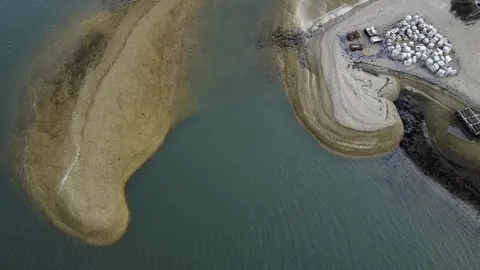Shifting Solent sandbank near Hurst Spit prompts warning
A shifting bank of shingle in the Solent has prompted a warning to sailors.
Lymington RNLI said the bank, measuring a few hundred metres in length, emerges at low tide to the east of Hurst Spit near Lymington.
It said the shingle bar continued to change size and location, and had made the water "considerably shallower".
Seafarers have been told to be "extra careful" when navigating around the spit.
 Nick Boxall
Nick BoxallThe RNLI said its crews had been monitoring the progress of the sandbank which sailors encounter as they navigate eastwards around a shallow bar know as "The Trap".
Lifeboats operations manager Alastair MacKay said: "We've been watching for the last month or two - it seems to have grown in that time to what we see now.
"A lot of boaters out there won't be aware of it. Even at high tide, the water is going to be much more shallow. The potential is for boats to go aground on it - that's what we're worried about it."
He warned that existing nautical charts would not show the formation so should be considered "inaccurate".
'Complex coastal environment'
The sandbank has formed close to Hurst Castle, part of which collapsed in February 2021 after the sea exposed and undercut its foundation.
Work has been going on to create a 90m (295ft) revetment and shore up its sea defences using thousands of tonnes of shingle and rock.
In a statement, English Heritage said: "The Hurst Spit and the wider coastal environment around Hurst Castle is complex and ever-changing, facing issues such as longshore drift, rising sea levels and more frequent storms.
"Any work undertaken to care for Hurst Castle is carried out as part of the Beach Management Plan and in close discussion with those statutory bodies responsible."
Sandbanks in the Solent are a well known hazard to shipping - the QE2 liner ran aground on the morning of its final departure from Southampton in 2008.

Follow BBC South on Facebook, Twitter, or Instagram. Send your story ideas to [email protected].
